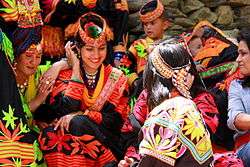Pakistanis
|
| |
| Total population | |
|---|---|
| c. 199 million[1] | |
| Regions with significant populations | |
|
| |
| 1,500,000+ | |
| 1,460,000+ | |
| 1,200,000+ | |
| 700,000 | |
| 415,310 | |
| 151,000+ | |
| 150,000+ | |
| 90,000[2] | |
| 85,000 | |
| 80,000 | |
| 60,000 | |
| 56,000 | |
| 54,000[3] | |
| 49,000 | |
| 47,000 | |
| 45,000 | |
| 39,134 | |
| 31,277 | |
| 30,000 | |
| 14,500+ | |
| 10,000+ | |
| 5,000+ | |
| Languages | |
| Urdu, Punjabi, Sindhi, Pashto, Balochi, Saraiki, Kashmiri, Brahui, Balti and others | |
| Religion | |
| Islam 97% (majority Sunni, while 20% being Shia) Other Religions: Hinduism, Christianity, Ahmadiyya, Bahai Faith, Sikhism, Zoroastrianism | |
| Part of a series on the |
| Culture of Pakistan |
|---|
 |
| Traditions |
|
Mythology and folklore |
| Cuisine |
|
Music and performing arts |
| Sport |
|
Monuments |
|
Pakistanis (Urdu: پاكِستانى قوم; Pakistani Qaum) are the people who are citizens of the modern Islamic Republic of Pakistan. Pakistan is a multi-ethnic and multilingual state: the majority of its people belong linguistically to the Indo-Iranian group while the remaining minority mainly belongs to a small amount of other language groups and families. As of 2011, the estimated population of Pakistan was over 199 million[1] making it the world's sixth most-populous country.
Ethnic sub-groups
Pakistan has one of the world's fastest growing populations. As the country is located in South Asia, Pakistani people are a mixture of various indigenous ethnic groups.
Pakistani people belong predominantly to seven main ethno-linguistic groups: Punjabi, Sindhi, Saraiki, Pashtun, Mohajir, Baloch, and Kashmiri, with substantial numbers of Brahui, Hindkowan, Shin, Burusho, Wakhi, Balti, Chitrali and other minority ethnic groups in the remote north of the country.
The Punjabi people, the largest ethnic group in Pakistan, reside predominantly in Central and some Northern regions as well. Punjabis have been the primary inhabitants of the historical Punjab region which derives its name from the Persian Panj meaning five (5) and Ab meaning water(s); hence the land of five rivers or Panjab/Punjab. Considerable population of Punjabis live in Karachi as well. The Baloch people inhabit the southwest of the country. The Sindhi people, on the other hand have been settled in the southeast of the country and gave their name to the mighty Indus/Sindhu river, while regional groups such as the Saraiki people have inhabited the regions between Punjab and Sindh.[4] The Kashmiri people are an important ethnic group of the Kashmir region in the north. There are other important indigenous people like the Balti, Hunzakots, and Gilgiti people(s) of the northern territories of Gilgit through whose territory ran the ancient Silk Route connecting Asia and Europe. The Chitrali people are another indigenous people who live high in the mountains in the northwest. Along with these main groups, there are smaller communities of Sheedi's who are descendants of African sailors and warriors who are believed to have arrived from the horn of Africa, as well as Muhajir people who came as refugees from India when Pakistan attained its independence from Britain in 1947. There are countless other ethnic groups that make up part of Pakistani's mosaic such as the Bengalis, Burmese, Hazara, Tajik and Hakka; the last are an ethnic group that traces its origin to China.[4]
Culture
Pakistan has a heterogeneous culture, with all of the provinces maintaining differing social mores. However, Islam is the driving force behind the unity of varying ethnic groups from different parts of the country, and has significantly shaped the values and traditions of Pakistanis. Pakistani culture falls in the category of high context.
Languages
Urdu, a major standard register of Hindustani, is Pakistan's national language. Urdu was chosen as a token of unity and as a lingua franca so as not to give any native Pakistani language preference over the other. It is mostly learned as a second language, with nearly 93% of Pakistan's population having a mother tongue other than Urdu. Urdu is spoken as a first, second or at times third tongue by almost all Pakistani people. Numerous regional and provincial languages are spoken as first languages by the ethno-linguistic groups making up the country, with Punjabi having a plurality of native speakers with 45% of the total population. English is spoken at an official level and in most elite circles, as a legacy of the long British Raj colonial rule in the region.
Many Pakistanis worldwide speak the various regional languages of Pakistan such as: Urdu, Saraiki, Punjabi, Sindhi, Pashto, Balochi, and Kashmiri.
Religion
The largest religion practiced in Pakistan is Islam. Other religious groups in Pakistan include Judaism, Sikhism, Zoroastrianism, Buddhism, Hinduism and Christianity.
Diaspora
There are large populations of Pakistani ancestry around the world, due to emigration. The population of Pakistanis abroad is considered to exceed seven million and can be found in the Middle East, North America, Europe, Asia and Australia.
Notable people
Further reading
- Starr, L.A. Frontier Folk of the Afghan Border—and Beyond. London: Church Missionary Society (1920).
References
- 1 2 "U.S. and World Population Clock". United States Census Bureau.
- ↑ Qatar´s population by nationality bq magazine Retrieved 15 December 2014
- ↑ http://www.immigration.go.kr/HP/COM/bbs_003/ListShowData.do?strNbodCd=noti0096&strWrtNo=124&strAnsNo=A&strOrgGbnCd=104000&strRtnURL=IMM_6050&strAllOrgYn=N&strThisPage=1&strFilePath=imm
- 1 2 Pakistani people
